- Books Name
- CBSE Class 7 Science Book
- Publication
- Param Publication
- Course
- CBSE Class 7
- Subject
- Science
Speed :
It is the characterstic of an object which decide the motion of an object. Distance covered in a unit time is called speed.
![]()
It is measured in m/sec.
Unit of speed
The basic units of speed is meter/second, which can also be expressed in m/min, km/h etc.
Kind of speed:
(i) Uniform speed : Consider a car moving on a road such that it covers, say 10 m in one second. If it covers 10 m in every subsequent second, then its speed is said to be uniform. Thus, when a body covers equal distances in equal intervals of time, however small the time interval may be, then the speed of the body is said to be uniform.
(ii) Non-uniform speed : When a body covers unequal distances in equal intervals of time or when it covers equal distances in unequal intervals of time, then the speed of the body is said to be non-uniform. Motion of a bus after application of brakes is an example of non-uniform speed.
(iii) Instantaneous Speed : The speed of an object at any particular instant of time or at a particular point of its path is called the instantaneous speed of the object. It is measured by speedometer in an automobile.
(iv) Average Speed : For an object moving with variable speed, it is the total distance travelled by an object divided by the total time taken to cover that distance.
![]()
Ex.2 A bus leaves Delhi 7 PM and reaches Mumbai at 9 PM. The speed of the bus is 20 km/h. What is the distance between Mumbai and Delhi ?
Sol. Distance = Speed × Time = 20 × 2 = 40 km (Time = 9 – 7 = 2 hour)
Ex.3 A car travels at 10 m/s. Express the same speed in km/h.
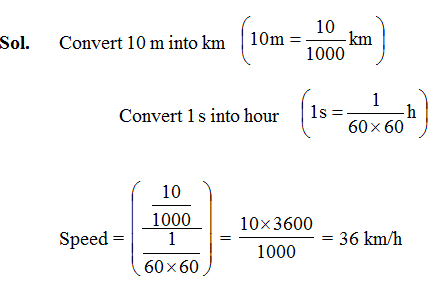
Ex.4 A car covers 1000 m in 10 sec and a cycle cover 50 m in 10 sec. Which one is faster ?
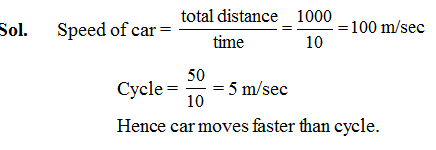
Ex.5 A car travels 30 km at a uniform speed of 40 km/h and the next 30 km at a uniform speed of 20 km/h. Find its average speed.
Sol. Given,
Total distance, d = (30 + 30) = 60 km
Speed for the first 30 km (u1) = 40 km/h
Speed for the next 30 km (u2) = 20 km/h
To calculate :
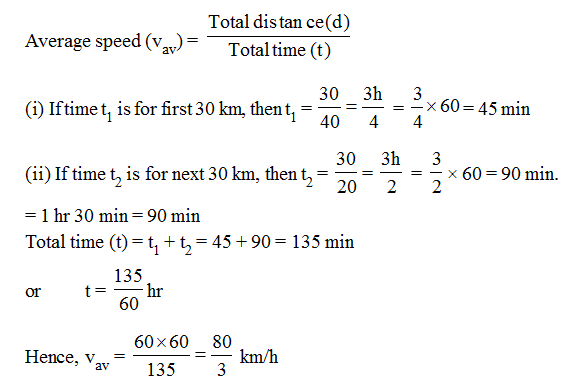
Velocity :
When an object moves with certain speed, it is not clear in which direction it is moving. To overcome the shortcoming, another term, velocity is used. In a way, velocity is speed in a specified direction. Thus, velocity consists of two parts out of which one part is direction. For example, a car moving with 10 ms–1 in east direction has the magnitude of velocity as 10 m s–1 and the direction is east.
It is the rate of change of displacement.

1. Uniform Velocity: When a body moves with uniform speed in a specified direction, it is said to be moving with uniform velocity.
Thus, a body moves with uniform velocity when its magnitude as well as its direction remains the same.
Example: Aeroplane moving with 500 km/hr towards east.
2. Variable velocity: When a body moves such that either its magnitude or direction or both change, then it is said to be moving with variable velocity.
Example: A car moving on a straight road such that its speed changes from time to time has variable velocity. A car taking a turn has variable velocity as its direction changes.
3. Instantaneous Velocity :
The velocity of an object at any given instant of time at particular point of its path is called its instantaneous velocity.
4. Average velocity: When a body moves with variable velocity, the average velocity of the body is equal to the ratio of total displacement of the body to the total time taken.
Average velocity = Total displacement / Total time taken
Difference between Speed and velocity :

Ex.6 An object travels with a velocity of 1.5 m/s eastwards for 2s and then with a velocity of 4 m/s northwards for 1s. What is its final displacement at the end of 3 s ? (Use property of right angles)
Sol. Displacement along OA = Velocity × Time = 1.5 × 2 = 3 m
Displacement along AB = Velocity × Time = 4 × 1 = 4 m
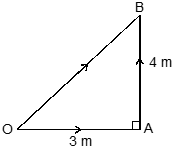

Ex.7 A car is moving along x-axis. As shown in figure it moves from O to P in 18 s and returns from P to Q in 6 sec. What is the average velocity and average speed of the car in going from (i) O to P and (ii) from O to P and back to Q.
![]()
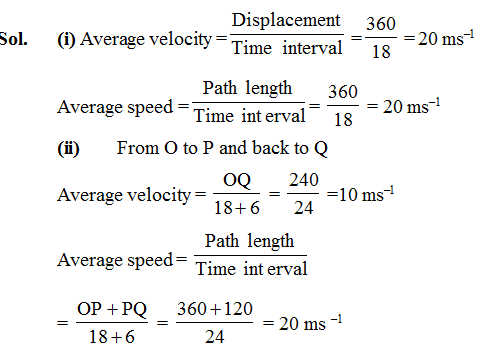

Acceleration :
Mostly the velocity of a moving object changes either in magnitude or in direction or in both when the object moves. Then the body is said to have acceleration.
The change in velocity of a body per unit time is called the acceleration or the rate of change of velocity is called the acceleration.
The SI unit of acceleration is ms–2. The other units of acceleration are cm s–2 and km h–2.
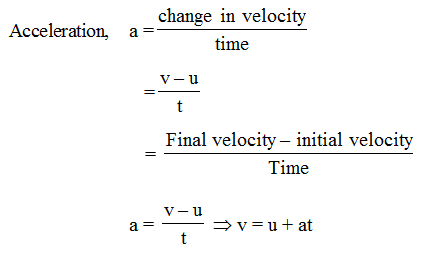
• Types of Acceleration :
(i) Positive acceleration: If the velocity of an object increases in the same direction, the object has a positive acceleration.
Eg. : A freely falling body.
(ii) Negative acceleration (retardation): If the velocity of a body decreases in the same direction, the body has a negative acceleration or it is said to be retardation.
Eg: A train slows down.
Ex.9 The velocity of a car at 10 : 50 am is 60 km/h and at 10: 52 am it is 80 km/h. Assuming constant acceleration in the given period, find its value.

Ex.10 An object is sliding down an inclined plane. The velocity changes at a constant rate from 10 cm/s to 15 cm/s in two seconds. What is its acceleration ?

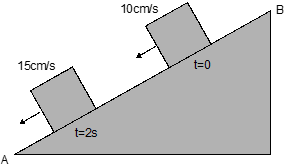

 Param Publication
Param Publication
